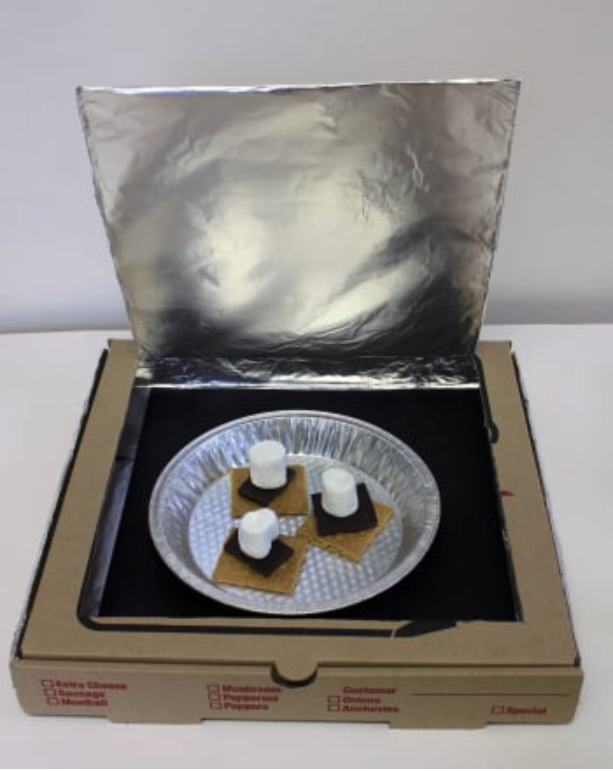Study Guide: Solar Oven
Vocabulary
- Heat
- Reflection
- Absorption
- Convection
- Insulation
- Radiation
Materials
- Cardboard pizza box
- Pencil
- Ruler
- Box cutter or scissors
- Aluminum foil
- Tape or glue
- Black construction paper
- Plastic wrap or large, transparent plastic bag
- Newspapers
- Oven mitt
- Dish or pie plate
- Cooking Ingredients for S’mores or nachos (don’t use your oven to prepare raw meat)
- Optional: Thermometer that goes up to 250 degrees F.
Procedures
- Clean any stray bits of old food from the pizza box.
- Using the ruler and pencil, draw a square one inch in from the edges of the top of the box.
- Use the box cutter or knife to cut out three of the four sides of this square.
- Make a crease along the uncut side of the square to create a flap that stands up.
- Cut a piece of aluminum foil large enough to cover the inner side of the cardboard flap. Wrap the foil tightly, and secure it with tape or glue. Don’t let the foil get wrinkled.
- Line the bottom of the pizza box with black paper.
- Cut two pieces of plastic wrap the same size as the top of the pizza box.
- Use tape to secure the plastic wrap to the inside edges of the square window.
- Roll up some newspaper or other scrap paper into tubes to stuff into the sides of the box. Make sure you are still able to close the lid.
- Optional: Add more pieces of aluminum covered cardboard to the oven design to increase the reflective surface.
Baking S’mores
- Set a tin pie pan or dish in the oven.
- Place one or two marshmallows on top of a graham cracker.
- Put a chuck of chocolate on top of the marshmallows.
- Set in the sun to bake, and angle the top so that it reflects the suns rays into the box.
- Once cooked, top it with the second graham cracker.
Baking Nachos
- Set a tin pie pan or dish in the oven.
- Fill the pan with a pile of chips.
- Add a few chopped jalapenos.
- Sprinkle grated cheese on top of it all.
- Set in the sun to bake, and angle the top so that it reflects the suns rays into the box.
The Science of the Solar Oven
Several natural phenomena are involved in a solar oven.
Heat is a form of energy (sometimes called thermal energy). Heat is transferred when there is a difference in temperature between to materials. The oven is designed to transfer heat from the sun into the over.
Reflection is the bouncing back of light by a material surface. The shiny foil in the oven reflects the sun’s light and heat into the oven.
During absorption, energy is taken into a material rather than reflected away from it. We lined the bottom of the oven with black paper to absorb the light and heat being reflected into the oven.
Convection is the transfer of heat by the movement of a gas or liquid. We use plastic wrap to make the oven airtight, so that the air in the oven can’t escape through convection.
Insulation is needed to prevent heat from escaping through heat radiation. We used newspaper or scrap paper to insulate the inside of the oven.
All of this works because energy from the sun is constantly being radiated to the earth.



